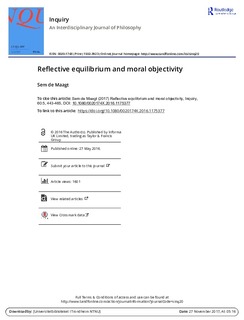| dc.contributor.author | de Maagt, Sem | |
| dc.date.accessioned | 2017-11-27T13:38:40Z | |
| dc.date.available | 2017-11-27T13:38:40Z | |
| dc.date.issued | 2017 | |
| dc.identifier.citation | Inquiry. 2017, 60 (5), 443-465 | nb_NO |
| dc.identifier.issn | 0020-174X | |
| dc.identifier.uri | http://hdl.handle.net/11250/2468145 | |
| dc.description.abstract | Ever since the introduction of reflective equilibrium in ethics, it has been argued that reflective equilibrium either leads to moral relativism, or that it turns out to be a form of intuitionism in disguise. Despite these criticisms, reflective equilibrium remains the most dominant method of moral justification in ethics. In this paper, I therefore critically examine the most recent attempts to defend the method of reflective equilibrium against these objections. Defenders of reflective equilibrium typically respond to the objections by saying that either reflective equilibrium can in fact safeguard moral objectivity or alternatively, even if it cannot, that there simply are no reasonable alternatives. In this paper, I take issue with both responses. First, I argue that given the non-foundationalist aspirations of reflective equilibrium, moral objectivity cannot be maintained. Second, I argue that reflective equilibrium is not the only game in town once intuitionism has been discarded. I argue that given their own normative ambitions, combined with their rejection of intuitionism, proponents of reflective equilibrium have reason to take alternative methods of moral justification, and more specifically transcendental arguments, more seriously than they have done so far. I end by sketching the outlines of what this alternative methodology might look like. | nb_NO |
| dc.language.iso | eng | nb_NO |
| dc.publisher | Taylor & Francis | nb_NO |
| dc.rights | Attribution-NonCommercial-NoDerivatives 4.0 Internasjonal | * |
| dc.rights.uri | http://creativecommons.org/licenses/by-nc-nd/4.0/deed.no | * |
| dc.title | Reflective equilibrium and moral objectivity | nb_NO |
| dc.type | Journal article | nb_NO |
| dc.type | Peer reviewed | nb_NO |
| dc.description.version | publishedVersion | nb_NO |
| dc.source.pagenumber | 443-463 | nb_NO |
| dc.source.volume | 60 | nb_NO |
| dc.source.journal | Inquiry | nb_NO |
| dc.source.issue | 5 | nb_NO |
| dc.identifier.doi | 10.1080/0020174X.2016.1175377 | |
| dc.identifier.cristin | 1372102 | |
| dc.relation.project | Norges forskningsråd: 217426 | nb_NO |
| dc.description.localcode | © 2016 The Author(s). Published by Informa UK Limited, trading as Taylor & Francis Group. This is an Open Access article distributed under the terms of the Creative Commons Attribution-NonCommercial-NoDerivatives License (http://creativecommons.org/licenses/by-nc-nd/4.0/), which permits non-commercial re-use, distribution, and reproduction in any medium, provided the original work is properly cited, and is not altered, transformed, or built upon in any way. | nb_NO |

